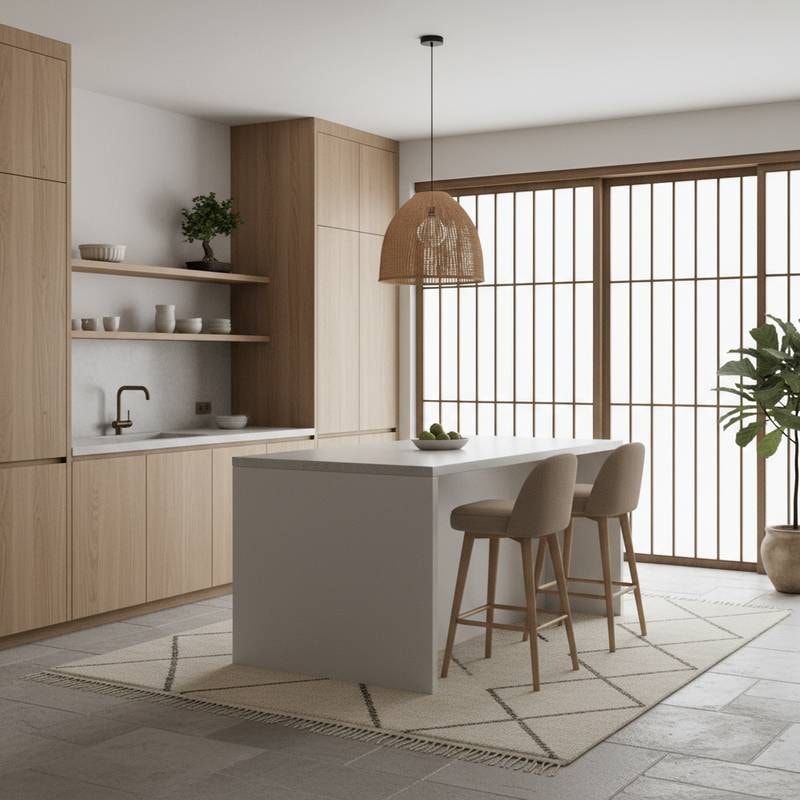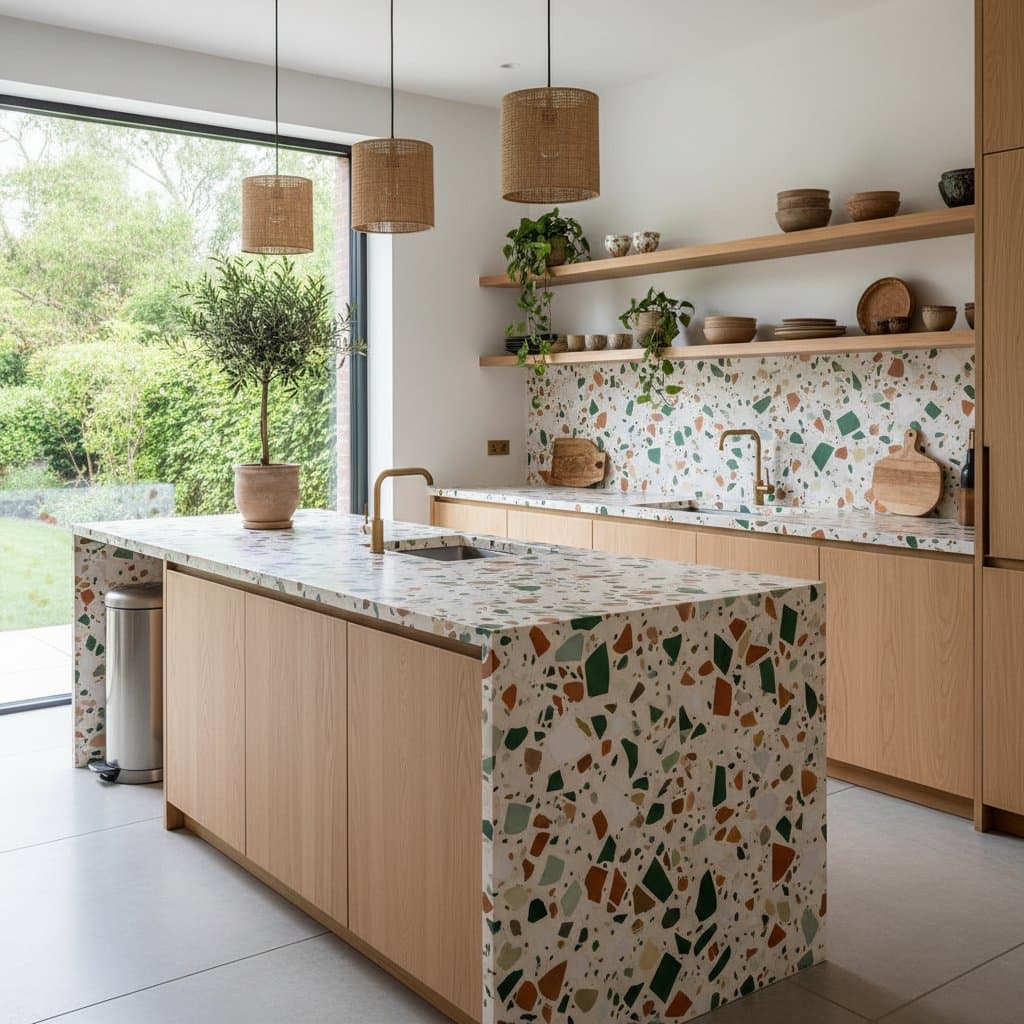Japandi: The Fusion Redefining Kitchen Design in 2025
Design enthusiasts often encounter images of kitchens that exude tranquility and efficiency. Light woods, streamlined forms, and a soothing atmosphere characterize these spaces across magazines and online platforms. This aesthetic, known as Japandi, merges Japanese simplicity with Scandinavian coziness, appealing to homeowners who seek equilibrium, elegance, and utility in their living areas.
Why Japandi Excels in Kitchen Settings
Kitchens frequently serve as the most active and disorganized rooms in a residence. Japandi addresses these issues by embracing minimalism as a deliberate way of life rather than a fleeting fashion. Japanese principles emphasize harmony and restraint, while Scandinavian influences prioritize ease and organic elements. The result is a kitchen that remains stable, orderly, and inviting.
Japandi designs incorporate organic textures, gentle neutral shades, and strategic storage solutions. Surfaces stay unadorned, and organization remains unobtrusive. The focus lies on crafting a peaceful work area that enhances routine activities without overwhelming visual elements.
Essential Components of a Japandi Kitchen
When undertaking a renovation or minor update, prioritize these key aspects to achieve the style:
-
Organic Materials
Select woods, stones, and clays to infuse warmth without superfluous ornamentation. Cabinetry in oak, ash, or bamboo complements matte stone countertops effectively. Steer clear of glossy surfaces that create harsh reflections. -
Subdued Neutral Tones
The palette features beiges, sands, charcoals, and pale whites. Introduce subtle contrasts by combining lighter hues with gentle grays or black details to build dimension. -
Streamlined, Purposeful Arrangements
Each feature must fulfill a practical role. Open shelves may showcase organized ceramics, yet primary storage should conceal items efficiently. Eliminate elaborate trims or oversized fittings. -
Matte Surfaces and Gentle Illumination
Japandi prefers soft, scattered light sources. Swap bright ceiling lights for warm under-cabinet strips or pendants crafted from paper or plant-based fibers. -
Eco-Conscious Selections
Rooted in Japanese and Scandinavian heritage, the style values durable workmanship. Incorporate ethically harvested woods, repurposed substances, and appliances that conserve energy.
Implementing Japandi: A Guided Approach
Achieve this aesthetic in your kitchen through these sequential steps, suitable for new builds or existing setups.
-
Initiate with Organization
Eliminate items not used regularly. An orderly foundation underpins the design. For constrained storage, acquire drawer dividers and hidden compartments. -
Establish the Primary Color Scheme
Choose a light neutral base and a deeper complementary shade. Consider white oak cabinets with charcoal flooring or light stone surfaces paired with dark hardware. Restrict patterns to essentials. -
Incorporate Authentic Textures
Install cabinetry and floors that reveal wood grains naturally. Quartz or polished granite suits countertops well. Avoid synthetic or reflective coverings. -
Introduce Subtle Accents
Woven containers, linen cloths, and earthenware items add dimension discreetly. Position a lone potted herb or a modest arrangement of twigs to inject vitality while preserving serenity. -
Harmonize Tonal Balances
Scandinavian elements tend toward cooler shades, whereas Japanese designs favor warm timbers. Blend them for cohesion, such as light gray walls alongside amber cabinetry. -
Refine Illumination Layers
Employ multiple sources: recessed options for utility and pendant or sconce lights for mood. Select bulbs that emit warm tones, mimicking daylight.
Key Factors: Expenses, Duration, and Expertise Required
Budget Estimates:
- Self-Directed Updates: $2,000 to $5,000 covers repainting, shelf installations, fixture changes, and light modifications.
- Moderate Overhauls: $20,000 to $35,000 includes semi-custom cabinets, fresh counters, new floors, and updated devices.
- High-End Transformations: $50,000 or more for bespoke cabinetry, advanced appliances, and premium substances.
Project Timelines:
Weekend efforts suffice for minor adjustments when handled personally. Comprehensive changes involving cabinet swaps and flooring installations span weeks, influenced by specialist schedules and supply delays.
Required Skills:
Tasks like painting, shelving, and light setups suit skilled amateurs. Professionals with licenses should manage cabinetry, surfaces, and wiring. Consult local regulations prior to any alterations affecting structure.
Adaptations for Varied Environments
Japandi accommodates diverse conditions and scales seamlessly. In cooler areas, accentuate Scandinavian traits with plush wool mats or substantial drapes for added comfort. Warmer regions benefit from Japanese lightness through airy, pale finishes. High-moisture zones demand sealed woods to resist distortion.
Enduring Benefits and Upkeep
Japandi kitchens mature elegantly, sidestepping transient styles. Organic materials gain appealing patinas with age. Maintenance proves straightforward due to sparse detailing; apply gentle cleansers to surfaces and periodically condition wooden areas. The versatile neutrals facilitate simple refreshes via accessory swaps alone.
Advancing Your Japandi Kitchen
Embrace Japandi by focusing on serenity and utility over flawlessness. Begin modestly: update pulls to matte finishes in black or brass, recoat cabinets in soft hues, or integrate wooden elements. Gradually assemble the complete vision within financial limits.
This approach yields more than visual appeal. It cultivates a space that promotes mindful routines. Surfaces, lights, and details collaborate to elevate daily tasks, whether preparing full courses or simple meals. Through deliberate choices, your kitchen evolves into a harmonious home centerpiece.









